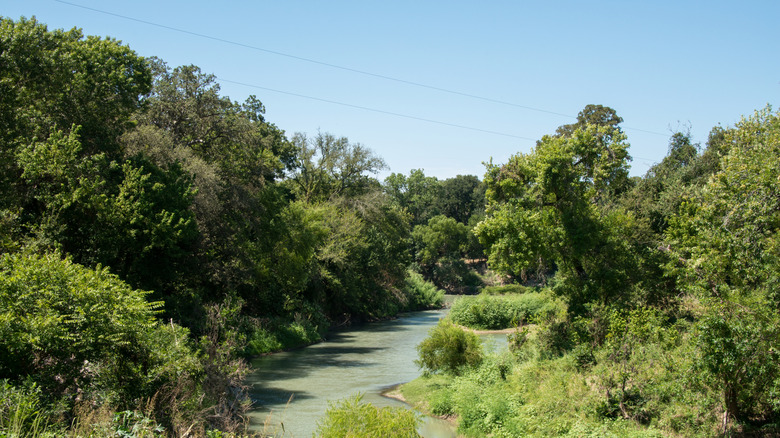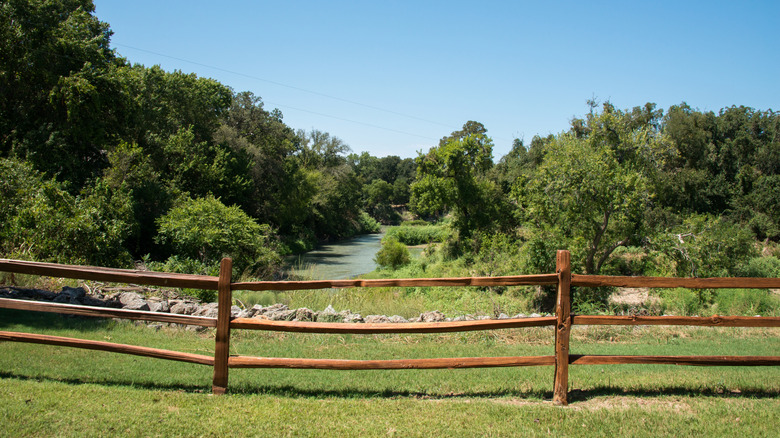
As large as Texas is, the Lone Star State's epic outdoor beauty is usually defined by the stunning beaches and marine wildlife of coastal spots like South Padre Island, or the rugged desert peaks of Guadalupe Mountains National Park. However, between these eastern and western extremes lies a vast landscape of incredible outdoor destinations, including many you wouldn't necessarily expect in Texas. One prime example is the remarkable Palmetto State Park. Tucked away in Texas's south-central corner
(about an hour or two from Houston, Austin, and San Antonio), Palmetto State Park looks much more like a scene from Florida or South Carolina than the desert plains of the Lone Star State. That's because Palmetto State Park is not in Texas's desert plains at all, but rather a uniquely rich collection of lush wetlands that look much more like a tropical rainforest than the arid Chihuahuan Desert.
Palmetto State Park's vibrant haven of greenery comes courtesy of its multiple water sources. Among the park's fertile waterways are the scenic San Marcos River and the 4-acre Oxbow Lake, plus smaller swamps and artisanal wells. Nutrient-rich water sources mean an abundance of plants — in this case, a thriving population of lovely dwarf palmetto palms from which the park gets its name. As a tropical plant, the dwarf palmetto is only found in a few places in Texas, making its namesake state park a unique Texas experience. The park's jungle-like forest is home to an equally rich menagerie of wildlife, including otters, armadillos, and a natural aviary of birds. Palmetto State Park also has some historical significance to accompany its natural beauty, with much of the park's infrastructure built by the Civilian Conservation Corps in the 1930s, and many surrounding areas playing a role in the Texas Revolution a century earlier.
Read more: The 5 Most Alligator-Filled Destinations In All Of Florida
What To Do In Palmetto State Park

Day access to Palmetto State Park costs $3 for visitors 13 and older (children 12 and younger get in for free). The modest price of admission is worth it for sightseeing alone. However, Palmetto State Park is also a superb spot for all sorts of outdoor activities. On land, Palmetto's one-of-a-kind forest is home to numerous top-notch hiking trails. Not only do the park's trails provide up-close views of the San Marcos River, Oxbow Lake, and the park's primeval forest setting, but the relatively flat terrain also makes the hikes relatively easy for most visitors. Hikes like the River Trail Loop provide a short and scenic tour of magical riverside scenery. The Ottine Swamp Trail even lets you explore a wetland ecosystem that looks straight out of Jurassic Park from a comfortable paved trail and boardwalk. During your hikes, you'll enjoy shade from the Texas Sun courtesy of the tall and lush trees that resemble the towering canopy of South Carolina's Congaree National Park.
If you're a birdwatcher, Palmetto State Park is a terrific destination to add some more depth to your birding life list. The park's verdant forest shelters one of Texas's most diverse avian communities, including numerous species of hawks, warblers, herons, owls, woodpeckers, waxwings, ibis, sandpipers, swallows, and so much more! Palmetto's waterways are also excellent for paddling activities. Local outfitters like Paddle EZ even offer kayak and canoe rentals, and some areas even allow swimming and fishing. If you want to stay overnight, Palmetto State Park has campsites with electricity (for $18 per night) and running water (for $12 per night). For $65 per night, you can even stay in the park's historic riverside cabin, complete with electricity, running water, and air conditioning.
Ready to discover more hidden gems and expert travel tips? Subscribe to our free newsletter for access to the world's best-kept travel secrets.
Read the original article on Islands.














